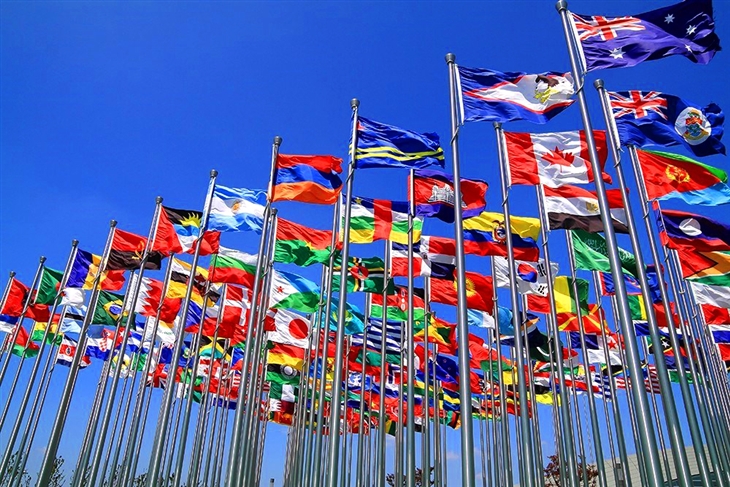Footwear exports increase in most markets with FTAs
Friday, February 14,2025
AsemconnectVietnam - Except for EAEU bloc, which decreased, Vietnam's footwear and handbag exports to markets with free trade agreements (FTAs) all increased, the highest being 20%.
Exports increase in most markets
According to Vietnam Leather, Footwear and Handbag Association, Vietnam is currently the third largest footwear producer after China and India with 1.4 billion pairs but the second largest exporter of these items.
In 2024, Vietnamese footwear industry export 26.8 billion USD, of which footwear reach 22.5 billion USD and handbags reach 4.3 billion USD. From 2019 to 2024, in general, the industry's export growth chart is relatively stable, except for a sudden increase in footwear in 2022; the specific figures are 21.46 billion USD; 19 billion USD; 20.47 billion USD; 27.59 billion USD; 23.94 billion USD and 26.8 billion USD, respectively.
In 2024, the US continue to be the largest importer of footwear and handbags from Vietnam with over 8.232 billion USD and over 1.762 billion USD; followed by the EU with over 6.478 billion USD and over 883 million USD. In addition, a number of other markets also import large quantities of footwear from Vietnam such as China with over 1.907 billion USD, Japan with over 1.048 billion USD, South Korea with over 645 million USD; for handbags, Japan imported over 315 million USD; China and South Korea are similar at around over 150 million USD. In particular, leather and footwear are recognized as one of the industries that make good use of the free trade agreements that Vietnam has signed. Looking at export results for the first 11 months of 2024, it can be seen that, in addition to Eurasian Economic Union market, which decreased by 127% to only 6.29 million USD, markets with free trade agreements in other sectors all grew positively.
Of which, market under Vietnam - United Kingdom and Northern Ireland Free Trade Agreement (UKVFTA) increased the most by 20%, reaching over 1 billion USD; ranked second is Vietnam - EU Free Trade Agreement (EVFTA) market, increasing by 14%, reaching over 5.91 billion USD; ASEAN market increased by 8%, reaching over 575 million USD and Comprehensive and Progressive Agreement for Trans-Pacific Partnership (CPTPP) market increased by 7%, reaching over 3.4 billion USD.
Explaining sharp decline in the EAEU market, Ms. Phan Thi Thanh Xuan - Vice President of Association and General Secretary of the Vietnam Leather, Footwear and Handbag Association said that due to geopolitical conflicts in the region, which have greatly affected consumer demand, transportation difficulties have significantly reduced orders. There are even businesses that cannot export even though this was previously a stable consumer market.
In addition to exports, imports of leather for production in Vietnam in the past 11 months also increased and increased the most since 2018 with over 1.8 billion USD; value of imported machinery and equipment was only lower than the peak year of 2019 with 147.5 million USD; imports of raw materials and accessories for the garment and footwear industry reached over 6.4 billion USD.
Flexible response to market fluctuations
Thus, it can be seen that 2024 continues to be a successful year for the Vietnamese leather and footwear industry when it still maintains its export performance. By 2025, according to Vice President of Vietnam Leather, Footwear and Handbag Association, Vietnamese leather and footwear industry aims to increase exports by 10% compared to 2024, reaching a turnover of about 29 billion USD.
However, to achieve this goal, businesses must make great efforts, because next year, orders are likely to stabilize. However, businesses need to restructure to avoid being passive in the face of new fluctuations, especially change of government in the US, because this market accounts for nearly 40% of the industry's export proportion.
Rapid increase in logistics costs is also a major difficulty because the industry's export markets are mainly far away, such as the US and the EU.
Along with that are new requirements, such as greening requirements, labor-related requirements, etc., all requiring businesses to improve compliance. Another challenge is that labor force is increasingly scarce.
Meanwhile, export prices have barely increased, even being forced to decrease and production prices from China are used as a basis for negotiations, which also creates difficulties for businesses.
To overcome these challenges, experts say that the Government needs to have policies to support businesses, especially in building mechanisms and policies on clean energy and green energy. This support will help businesses access sustainable energy sources, meeting increasingly stringent requirements of international market. In addition, businesses also need to proactively improve their competitiveness, improve production technology, protect the environment and build sustainable supply chains...
Source: Vitic/ congthuong.vn
According to Vietnam Leather, Footwear and Handbag Association, Vietnam is currently the third largest footwear producer after China and India with 1.4 billion pairs but the second largest exporter of these items.
In 2024, Vietnamese footwear industry export 26.8 billion USD, of which footwear reach 22.5 billion USD and handbags reach 4.3 billion USD. From 2019 to 2024, in general, the industry's export growth chart is relatively stable, except for a sudden increase in footwear in 2022; the specific figures are 21.46 billion USD; 19 billion USD; 20.47 billion USD; 27.59 billion USD; 23.94 billion USD and 26.8 billion USD, respectively.
In 2024, the US continue to be the largest importer of footwear and handbags from Vietnam with over 8.232 billion USD and over 1.762 billion USD; followed by the EU with over 6.478 billion USD and over 883 million USD. In addition, a number of other markets also import large quantities of footwear from Vietnam such as China with over 1.907 billion USD, Japan with over 1.048 billion USD, South Korea with over 645 million USD; for handbags, Japan imported over 315 million USD; China and South Korea are similar at around over 150 million USD. In particular, leather and footwear are recognized as one of the industries that make good use of the free trade agreements that Vietnam has signed. Looking at export results for the first 11 months of 2024, it can be seen that, in addition to Eurasian Economic Union market, which decreased by 127% to only 6.29 million USD, markets with free trade agreements in other sectors all grew positively.
Of which, market under Vietnam - United Kingdom and Northern Ireland Free Trade Agreement (UKVFTA) increased the most by 20%, reaching over 1 billion USD; ranked second is Vietnam - EU Free Trade Agreement (EVFTA) market, increasing by 14%, reaching over 5.91 billion USD; ASEAN market increased by 8%, reaching over 575 million USD and Comprehensive and Progressive Agreement for Trans-Pacific Partnership (CPTPP) market increased by 7%, reaching over 3.4 billion USD.
Explaining sharp decline in the EAEU market, Ms. Phan Thi Thanh Xuan - Vice President of Association and General Secretary of the Vietnam Leather, Footwear and Handbag Association said that due to geopolitical conflicts in the region, which have greatly affected consumer demand, transportation difficulties have significantly reduced orders. There are even businesses that cannot export even though this was previously a stable consumer market.
In addition to exports, imports of leather for production in Vietnam in the past 11 months also increased and increased the most since 2018 with over 1.8 billion USD; value of imported machinery and equipment was only lower than the peak year of 2019 with 147.5 million USD; imports of raw materials and accessories for the garment and footwear industry reached over 6.4 billion USD.
Flexible response to market fluctuations
Thus, it can be seen that 2024 continues to be a successful year for the Vietnamese leather and footwear industry when it still maintains its export performance. By 2025, according to Vice President of Vietnam Leather, Footwear and Handbag Association, Vietnamese leather and footwear industry aims to increase exports by 10% compared to 2024, reaching a turnover of about 29 billion USD.
However, to achieve this goal, businesses must make great efforts, because next year, orders are likely to stabilize. However, businesses need to restructure to avoid being passive in the face of new fluctuations, especially change of government in the US, because this market accounts for nearly 40% of the industry's export proportion.
Rapid increase in logistics costs is also a major difficulty because the industry's export markets are mainly far away, such as the US and the EU.
Along with that are new requirements, such as greening requirements, labor-related requirements, etc., all requiring businesses to improve compliance. Another challenge is that labor force is increasingly scarce.
Meanwhile, export prices have barely increased, even being forced to decrease and production prices from China are used as a basis for negotiations, which also creates difficulties for businesses.
To overcome these challenges, experts say that the Government needs to have policies to support businesses, especially in building mechanisms and policies on clean energy and green energy. This support will help businesses access sustainable energy sources, meeting increasingly stringent requirements of international market. In addition, businesses also need to proactively improve their competitiveness, improve production technology, protect the environment and build sustainable supply chains...
Source: Vitic/ congthuong.vn
Imports and exports reached over 63 billion USD in January
Vietnam to create momentum for industrial production in 2025
DAILY: Vietnamese rice prices decreased slightly on February 13, 2025
DAILY: Vietnamese pepper prices decreased on February 13, 2025
DAILY: Vietnamese coffee prices rebounded on February 13, 2025
2025: What are main export markets for seafood products?
Coffee export turnover increased by 32.5% in 2024
Processing and manufacturing industry increased by 1.6% in January
Vietnam-Singapore import-export turnover in 2024 hits record
DAILY: Vietnamese pepper prices increased on February 12, 2025
DAILY: Vietnamese coffee prices decreased on February 12, 2025
DAILY: Vietnamese rice prices increased slightly on February 12, 2025
Exports of fruits and vegetables in January 2025 estimated to reach less than 400 million USD
Iron and steel exports increased by 8.8% in turnover in 2024

Plan of Hai Duong province for a period of 2021 - 2030, ...
Organize space reasonably and harmoniously, focusing on connecting Hai Duong in common development space, actively contributing to the ...Plan of Hau Giang province in a period of 2021 - 2030, ...
Sustainable forestry development program in a period of ...

Outstanding aquatic sport athletes honoured
More than 100 Vietnamese outstanding aquatic sport athletes were honoured at an event held in the southern province of Tay Ninh on ...Traditional music bridges Vietnamese, Chinese youth
Vietnamese player wins regional table tennis championships



